airbag TOYOTA YARIS SEDAN 2008 Owners Manual
[x] Cancel search | Manufacturer: TOYOTA, Model Year: 2008, Model line: YARIS SEDAN, Model: TOYOTA YARIS SEDAN 2008Pages: 384, PDF Size: 6.19 MB
Page 7 of 384
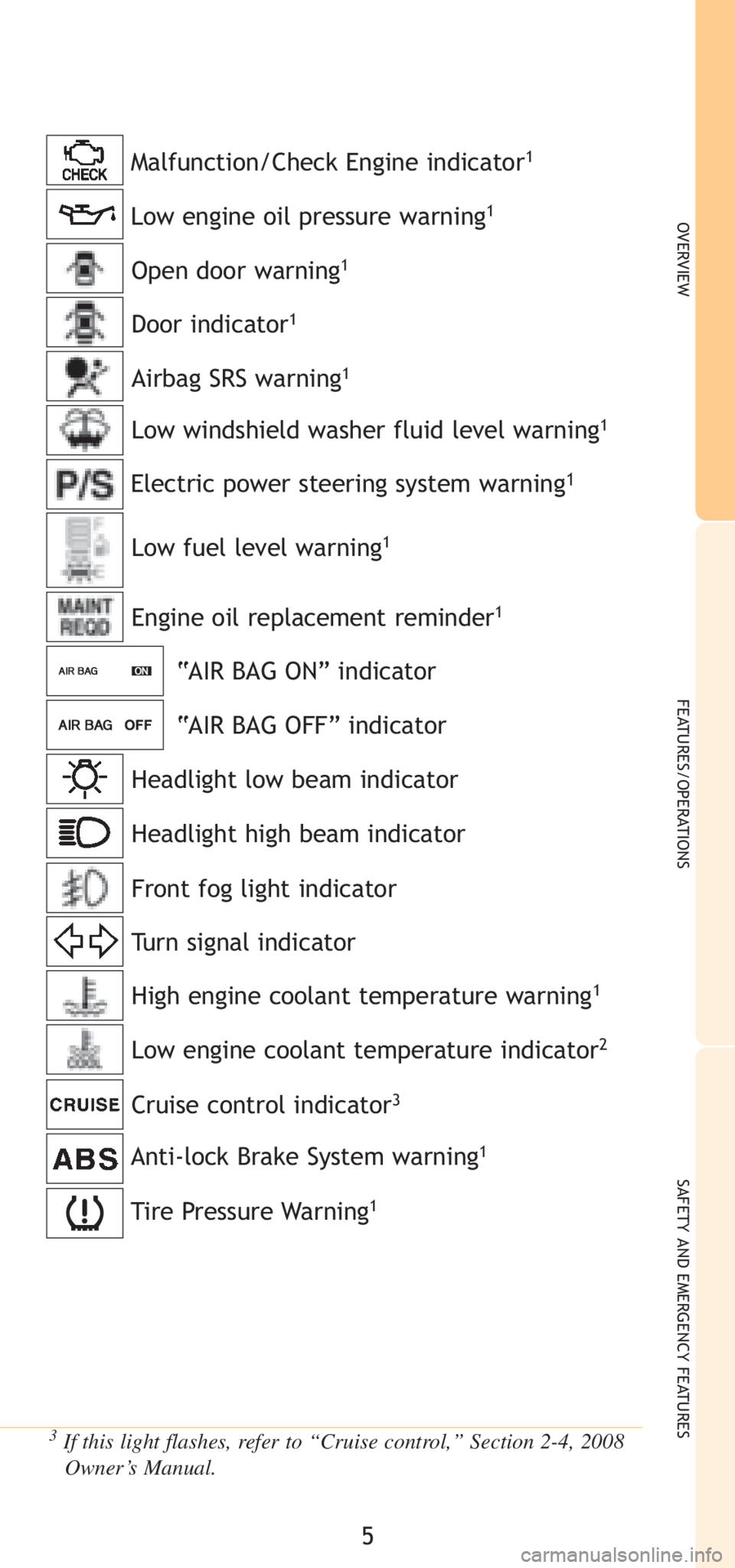
5
OVERVIEW
FEATURES/OPERATIONS
SAFETY AND EMERGENCY FEATURES
Low engine oil pressure warning1
Anti-lock Brake System warning1
Malfunction/Check Engine indicator1
3If this light flashes, refer to “Cruise control,” Section 2-4, 2008Owner’s Manual.
Open door warning1
Low windshield washer fluid level warning1
Engine oil replacement reminder1
“AIR BAG ON” indicator
“AIR BAG OFF” indicator
Headlight low beam indicator
Turn signal indicator
High engine coolant temperature warning1
Low engine coolant temperature indicator2
Headlight high beam indicator
Cruise control indicator
3
Front fog light indicator Airbag SRS warning
1
Low fuel level warning1
Door indicator1
Electric power steering system warning1
Tire Pressure Warning1
Page 23 of 384

17
Installation of a mobile two-way radio system
As the installation of a mobile two-way radio system in your vehicle could
affect electronic systems such as the multiport fuel injection system/sequen-
tial multiport fuel injection system, cruise control system, anti-lock brake sys-
tem, SRS airbag system and seat belt pretensioner system, be sure to check
with your Toyota dealer for precautionary measures or special instructions
regarding installation.
Scrapping your Toyota
The SRS airbag and seat belt pretensioner devices in your Toyota contain
explosive chemicals. If the vehicle is scrapped with the airbags and seat belt
pretensioners left as they are, this may cause an accident such as fire. Be
sure to have the systems of the SRS airbag and seat belt pretensioner
removed and disposed of by a qualified service shop or by your Toyota
dealer before you scrap your vehicle.
Perchlorate Material
Special handling may apply,
See www.dtsc.ca.gov/hazardouswaste/perchlorate.
Your vehicle has components that may contain perchlorate. These compo-
nents may include airbag, seat belt pretensioners, and wireless remote con-
trol batteries.
Page 30 of 384
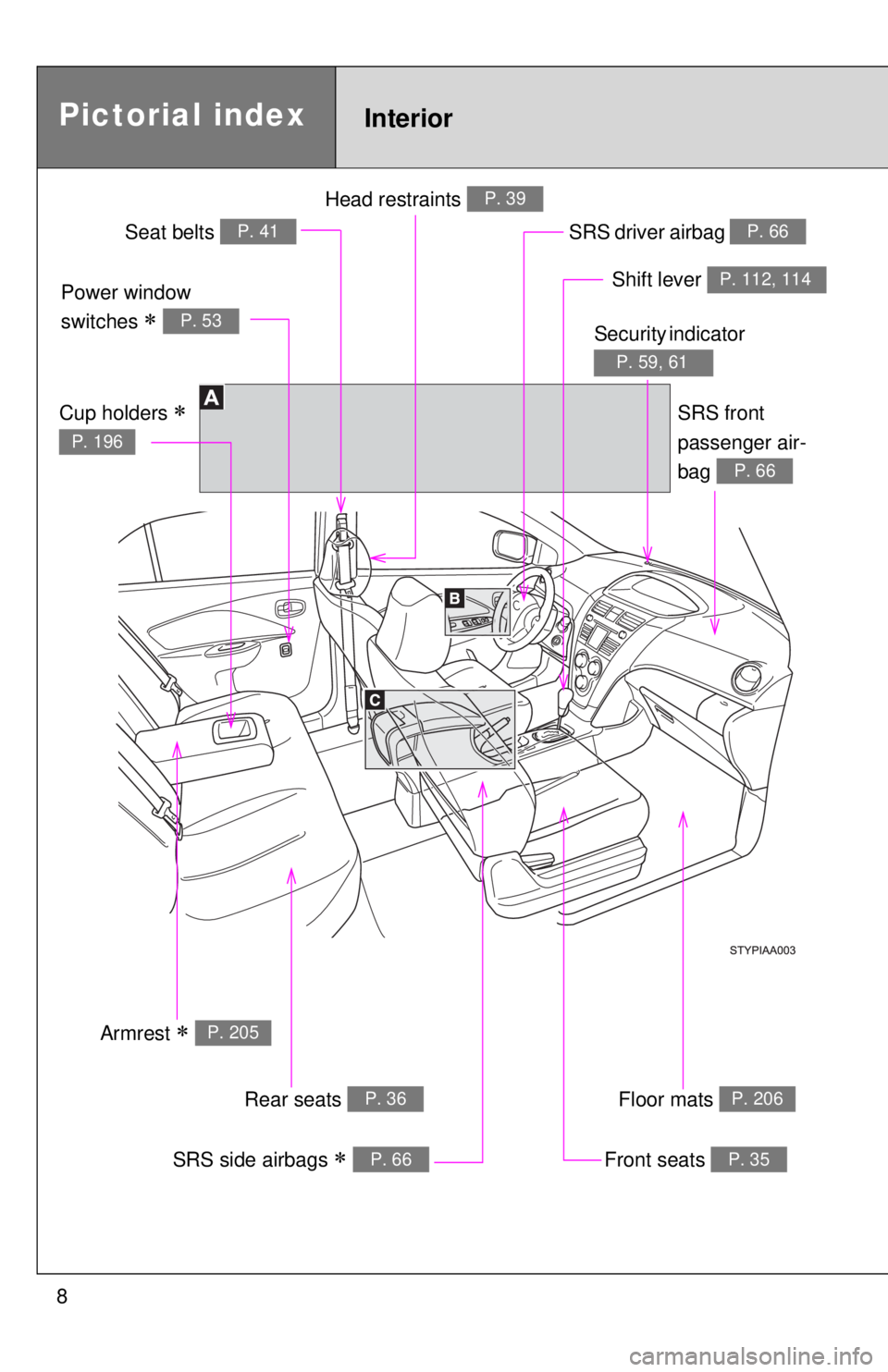
8
Power window
switches
∗ P. 53
Pictorial indexInterior
Seat belts P. 41SRS driver airbag P. 66
Head restraints P. 39
Cup holders ∗
P. 196
Armrest ∗ P. 205
Front seats P. 35SRS side airbags ∗ P. 66
Floor mats P. 206
SRS front
passenger air-
bag
P. 66
Shift lever P. 112, 114
Security indicator
P. 59, 61
Rear seats P. 36
Page 31 of 384
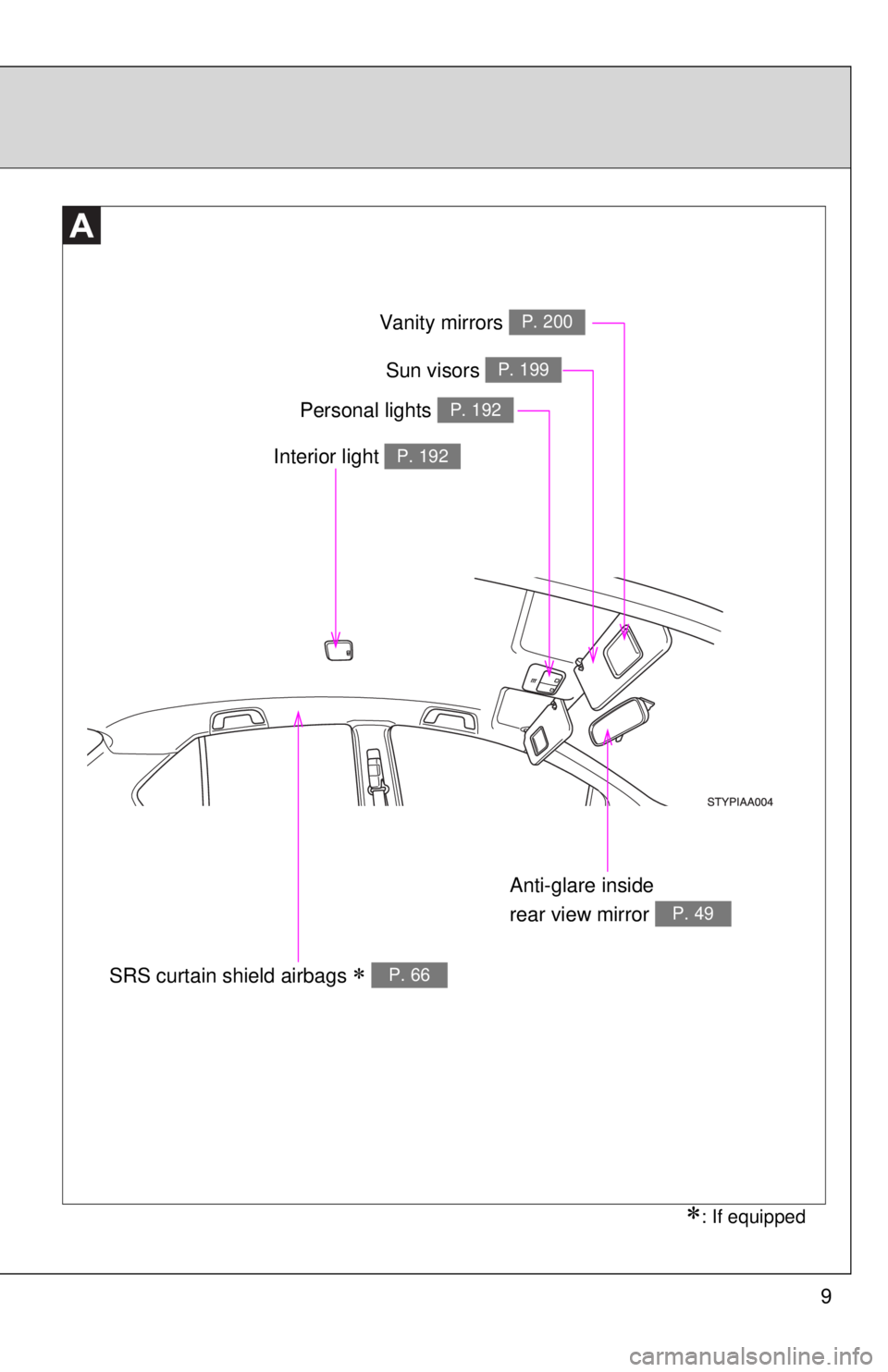
9
Anti-glare inside
rear view mirror
P. 49
Interior light P. 192
Vanity mirrors P. 200
Personal lights P. 192
Sun visors P. 199
SRS curtain shield airbags ∗ P. 66
∗: If equipped
Page 80 of 384
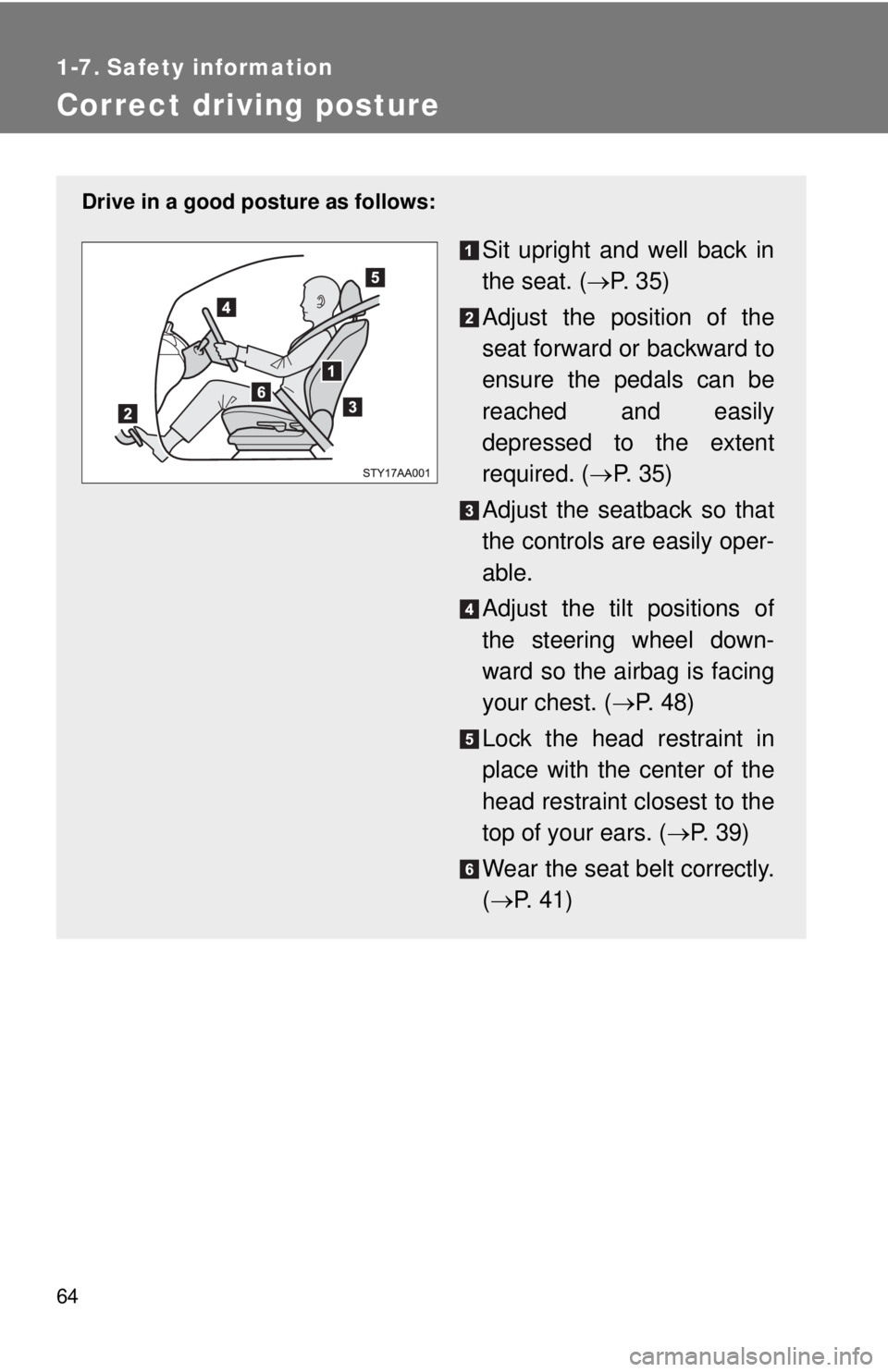
64
1-7. Safety information
Correct driving posture
Drive in a good posture as follows:
Sit upright and well back in
the seat. (→P. 3 5 )
Adjust the position of the
seat forward or backward to
ensure the pedals can be
reached and easily
depressed to the extent
required. ( →P. 35)
Adjust the seatback so that
the controls are easily oper-
able.
Adjust the tilt positions of
the steering wheel down-
ward so the airbag is facing
your chest. ( →P. 4 8 )
Lock the head restraint in
place with the center of the
head restraint closest to the
top of your ears. ( →P. 39)
Wear the seat belt correctly.
( → P. 41)
Page 82 of 384
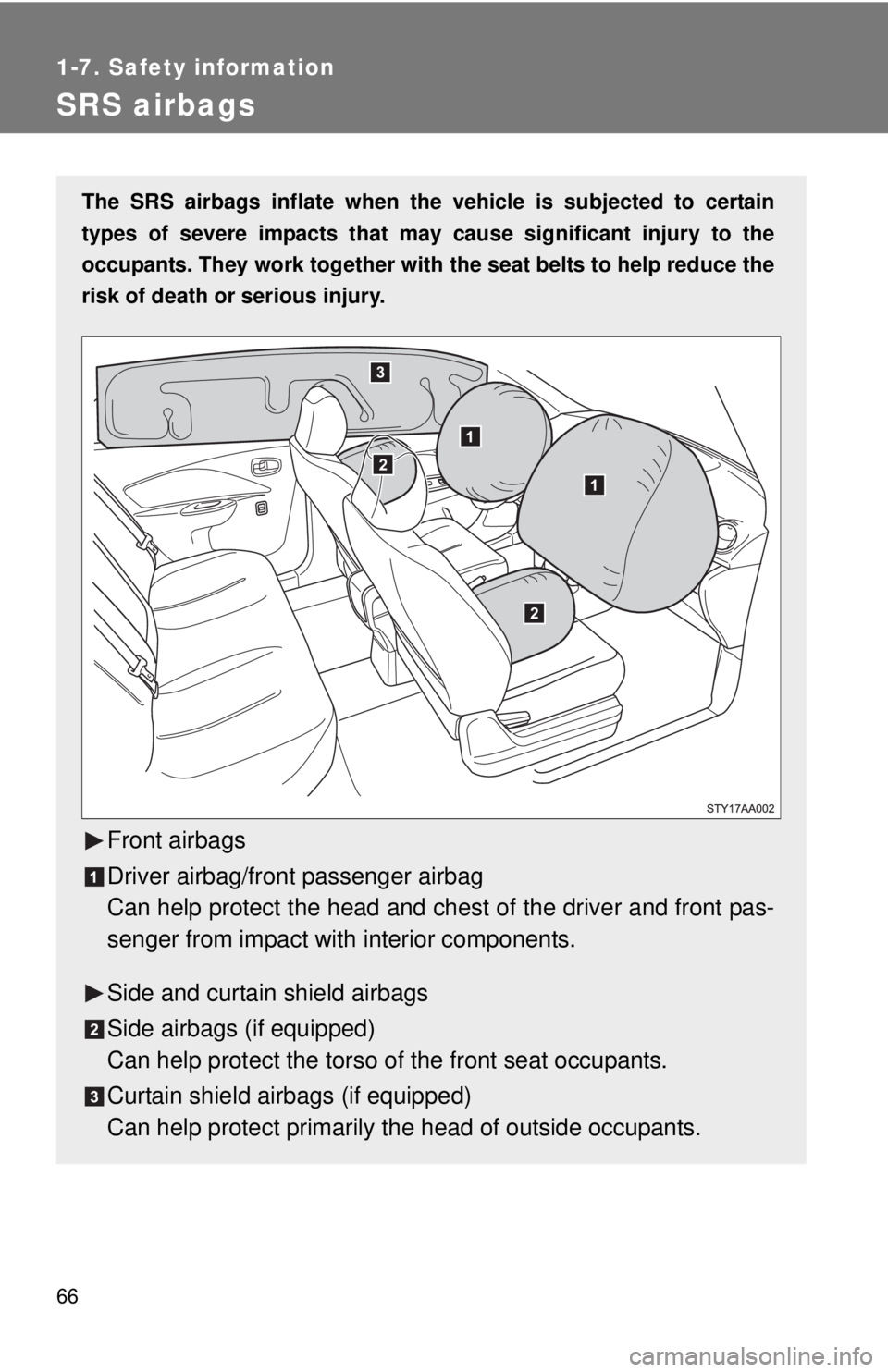
66
1-7. Safety information
SRS airbags
The SRS airbags inflate when the vehicle is subjected to certain
types of severe impacts that may cause significant injury to the
occupants. They work together with the seat belts to help reduce the
risk of death or serious injury.
Front airbags
Driver airbag/front passenger airbag
Can help protect the head and ches t of the driver and front pas-
senger from impact with interior components.
Side and curtain shield airbags
Side airbags (if equipped)
Can help protect the torso of the front seat occupants.
Curtain shield airbags (if equipped)
Can help protect primarily the head of outside occupants.
1
1
2
2
3
Page 83 of 384
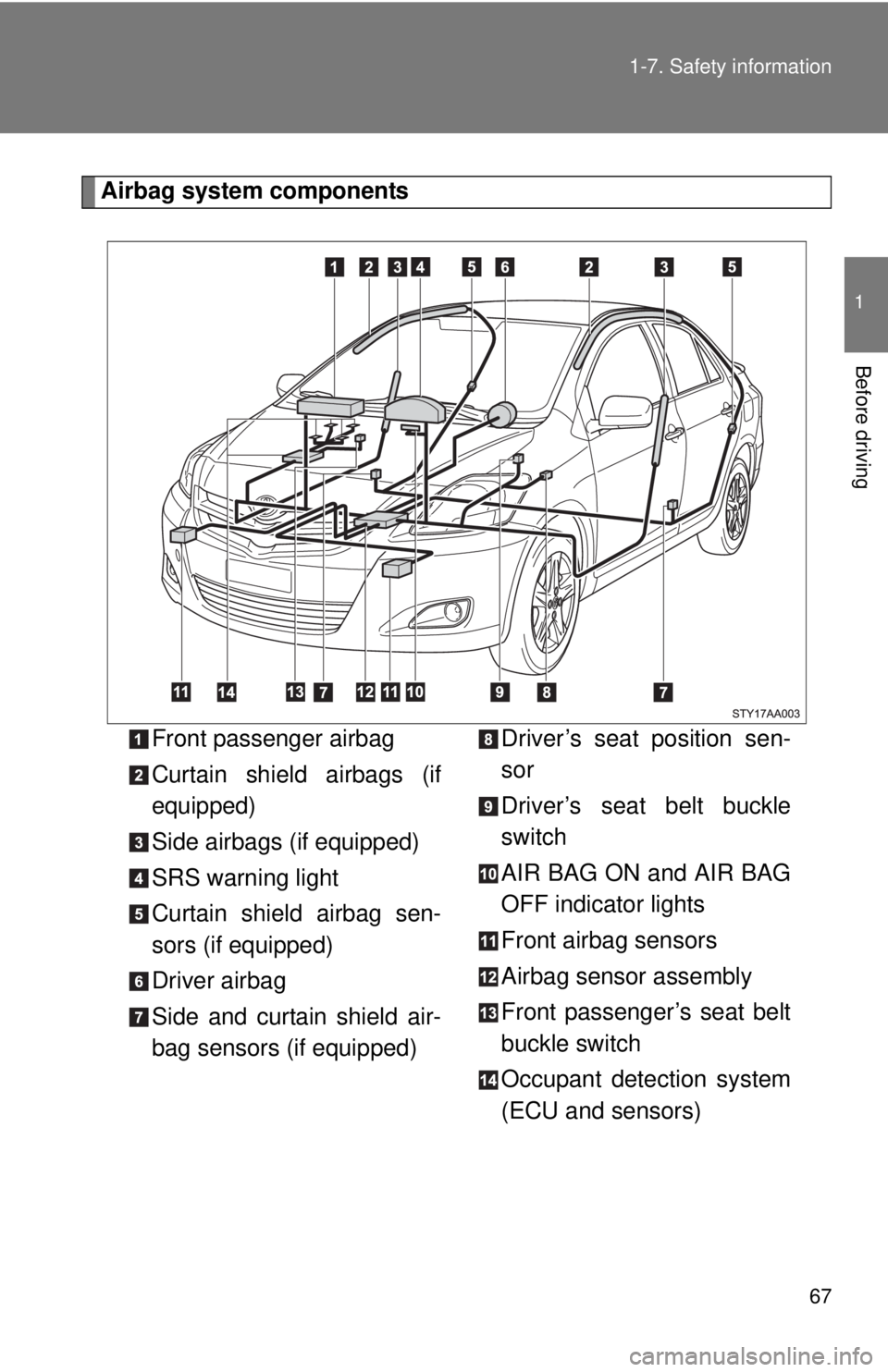
67
1-7. Safety information
1
Before driving
Airbag system components
Front passenger airbag
Curtain shield airbags (if
equipped)
Side airbags (if equipped)
SRS warning light
Curtain shield airbag sen-
sors (if equipped)
Driver airbag
Side and curtain shield air-
bag sensors (if equipped) Driver’s seat position sen-
sor
Driver’s seat belt buckle
switch
AIR BAG ON and AIR BAG
OFF indicator lights
Front airbag sensors
Airbag sensor assembly
Front passenger’s seat belt
buckle switch
Occupant detection system
(ECU and sensors)
Page 84 of 384

68 1-7. Safety information
Your vehicle is equipped with ADVANCED AIRBAGS designed based
on US motor vehicle safety standards (FMVSS208). The airbag sys-
tem controls airbag deployment po wer for the driver and front pas-
senger. The driver airbag system consists of the driver seat’s position
sensor etc. The front passenger’s airbag system consists of the front
passenger occupant classification sensor etc.
The main SRS airbag system components are shown above. The
SRS airbag system is controlled by the airbag sensor assembly. The
airbag sensor assembly consists of a safing sensor and an airbag
sensor.
In certain types of severe frontal or side impacts, the SRS airbag sys-
tem triggers the airbag inflators. A chemical reaction in the inflators
quickly fills the airbags with non-toxic gas to help restrain the motion
of the occupants.
n SRS warning light
This warning light system monitors the airbag sensor assembly, front airbag
sensors, side and curtain shield airbag sensors, curtain shield airbag sen-
sors, driver’s seat position sensor, driver’s seat belt buckle switch, front pas-
senger occupant classification system, AIR BAG ON indicator light, AIR
BAG OFF indicator light, front passenger’s seat belt buckle switch, seat belt
pretensioner assemblies, inflators, interconnecting wiring and power
sources. ( →P. 293)
n If the SRS airbags deploy (inflate)
lBruising and slight abrasions may result from contact with a deploying
(inflating) SRS airbag.
l A loud noise and white powder will be emitted.
l Vehicles with side and curtain shield airbags: Parts of the airbag module
(steering wheel hub, airbag cover and inflator) as well as the front seats,
and parts of the front and rear pillars and roof side rail, may be hot for
several minutes. The airbag itself may also be hot.
l Vehicles without side and curtain shield airbags: Parts of the airbag mod-
ule (steering wheel hub, airbag cover and inflator) as well as the front
seats may be hot for several minutes. The airbag itself may also be hot.
Page 85 of 384

69
1-7. Safety information
1
Before driving
n
If the SRS airbags deploy (inflate)
lThe front windshield may crack.
n Operating conditions (front airbags)
lThe SRS front airbags will deploy if the severity of the frontal impact is
above the designed threshold level, comparable to an approximate 15
mph (25 km/h) collision when the vehicle impacts straight into a fixed bar-
rier that does not move or deform.
However, this threshold velocity will be considerably higher if the vehicle
strikes an object, such as a parked vehicle or sign pole, which can move or
deform on impact, or if the vehicle is involved in an underride collision (e.g.
a collision in which the front of the vehicle “underrides”, or goes under, the
bed of a truck, etc.).
l It is possible that in some collisions where the forward deceleration of the
vehicle is very close to the designed threshold level, the SRS front air-
bags and the seat belt pretensioners may not activate together.
l The SRS front passenger airbag will not activate if there is no passenger
sitting in the front passenger seat. However, the front passenger airbag
may deploy if luggage is put in the seat, even if the seat is unoccupied.
(→ P. 7 8 )
n Operating conditions (side airbag s and curtain shield airbags [if
equipped])
l The SRS side airbags and curtain shield airbags are designed to inflate
when the passenger compartment is subjected to a severe impact from
the side.
l The SRS side airbag on the passenger seat will not activate if there is no
passenger sitting in the front passenger seat. However, the side airbag
on the passenger seat may deploy if luggage is put in the seat, even if
the seat is unoccupied. ( →P. 78)
Page 86 of 384
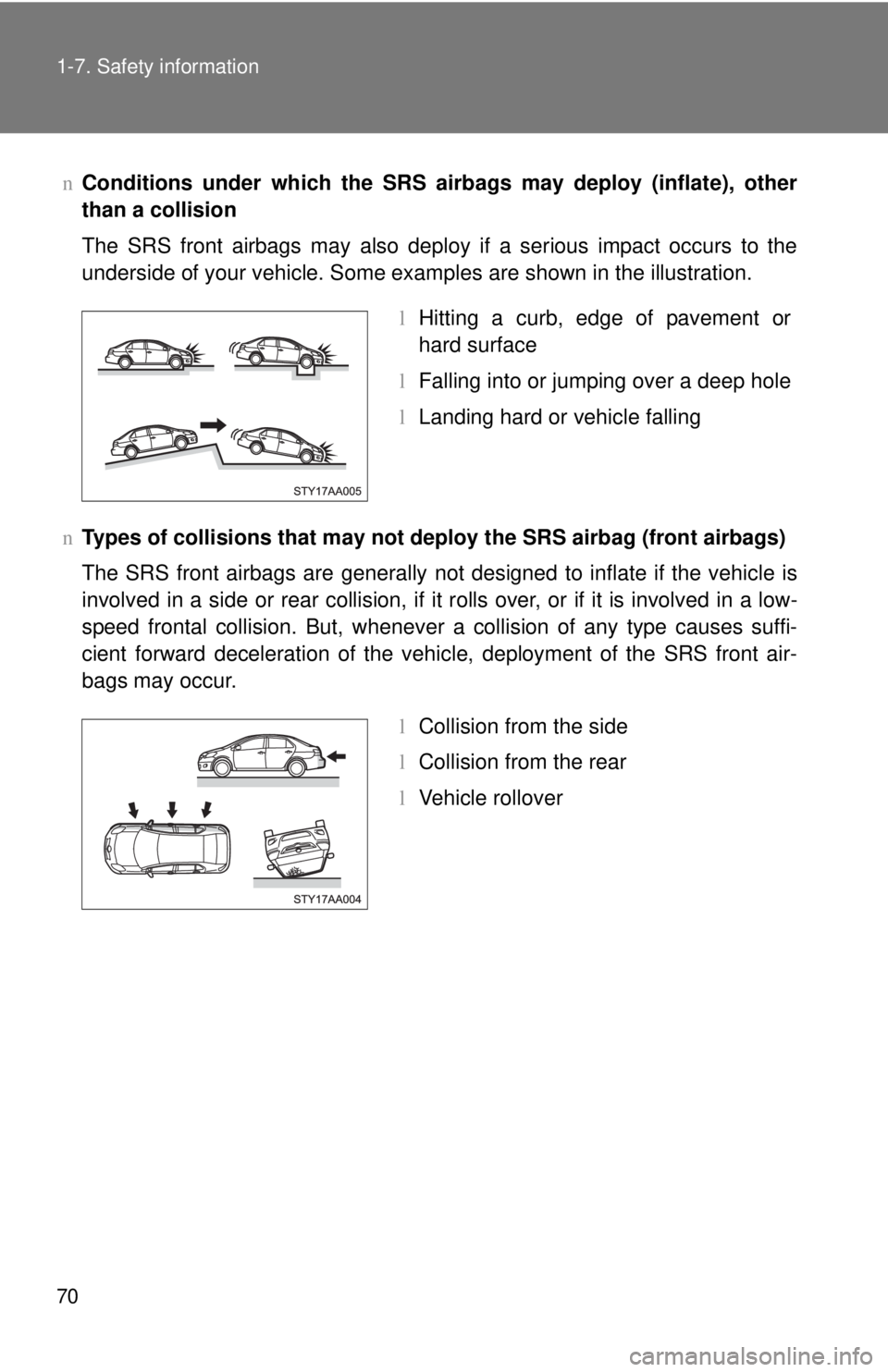
70 1-7. Safety information
nConditions under which the SRS airbags may deploy (inflate), other
than a collision
The SRS front airbags may also deploy if a serious impact occurs to the
underside of your vehicle. Some examples are shown in the illustration.
n Types of collisions that may not depl oy the SRS airbag (front airbags)
The SRS front airbags are generally not designed to inflate if the vehicle is
involved in a side or rear collision, if it rolls over, or if it is involved in a low-
speed frontal collision. But, whenever a collision of any type causes suffi-
cient forward deceleration of the vehicle, deployment of the SRS front air-
bags may occur.
l Hitting a curb, edge of pavement or
hard surface
l Falling into or jumping over a deep hole
l Landing hard or vehicle falling
lCollision from the side
l Collision from the rear
l Vehicle rollover